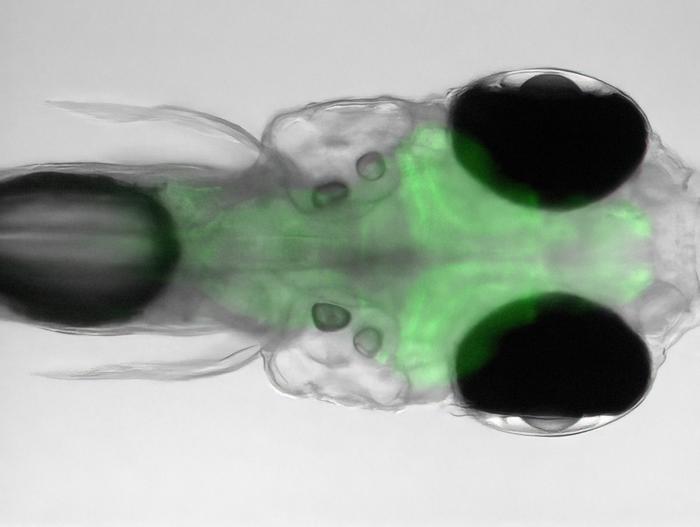All animals need to regulate their body temperature and cannot survive for long if it gets too high or too low. Warm-blooded organisms like humans have various ways to do this. They release heat by sweating or expanding the blood vessels in their skin, while shivering or burning fat in their brown adipose tissue has the opposite effect.

Credit: Image: Portugues Laboratory/TUM
All animals need to regulate their body temperature and cannot survive for long if it gets too high or too low. Warm-blooded organisms like humans have various ways to do this. They release heat by sweating or expanding the blood vessels in their skin, while shivering or burning fat in their brown adipose tissue has the opposite effect.
Cold-blooded animals such as the zebrafish, by contrast, cannot do any of these, so they have a different strategy. They look for places nearby that are at their “comfortable temperature,” just like how we might go out into the sun when we feel chilly or seek out some shade once it gets too hot. “We formed the idea that cold-blooded organisms use similar brain mechanisms to humans to find the ideal temperature conditions for them and that these help them to know where to go,” explains Professor Ilona Grunwald Kadow from the Institute of Physiology II at the University of Bonn and the University Hospital Bonn.
Fish larvae observed “thinking”
The zebrafish is perfect for testing this idea because its larvae are transparent. This allows scientists to look inside their brains while they perform certain tasks in the laboratory—and these researchers did just that. “The animals had been genetically modified to make their nerve cells produce a dye,” explains Grunwald Kadow from the University Hospital Bonn, who is also a member of the Transdisciplinary Research Area “Life & Health” at the University of Bonn. “This caused their neurons to light up when they were active, enabling us to see under the microscope which areas of their brains were working at that precise moment.”
In their experiments, the researchers surrounded the animals with water that they made hotter or colder. “Then we watched to see how they’d react,” Virginia Palieri explains. For her doctorate at TUM, she studied the degree of similarity between the mechanisms for regulating body temperature used by cold-blooded animals and their warm-blooded counterparts such as humans. “This told us that the fish prefer a temperature of 25.3 degrees Celsius. As soon as it got a few tenths of a degree cooler or warmer, they began to seek out more comfortable surroundings.”
“Satnav” increases the chances of finding ideal living conditions quickly
Two parts of their brain are activated in this process, the preoptic area of the hypothalamus (POA) and the dorsal habenula. The POA seems to be primarily responsible for detecting deviations from the fish’s ideal temperature. “When we switched off the animals’ POA, they stopped embarking on searches, even when the temperature of their water was some way off what made them comfortable,” Palieri says. Interestingly, mammals like us have a POA too. “And this region of the brain is likewise responsible for regulating temperature, even in these much more highly developed organisms,” Grunwald Kadow explains. “In them, however, it’s mainly responsible for automatic actions such as sweating or shivering—behavior less so.” Nevertheless, the study has revealed that the brain’s “thermostat” is extremely ancient, meaning that it developed very early on in the evolutionary process.
The habenula, for its part, clearly acts as a kind of “satnav,” showing the fish where it can locate a comfortable temperature and guiding it straight back there. “Thanks to their navigation system, the animals can find their way around very efficiently and make their way back quickly to the spot with the best temperature,” adds Professor Ruben Portugues from the Institute of Neuroscience at TUM and researcher in the Cluster of Excellence “SyNergy”, who led the study together with Ilona Grunwald Kadow.
Deactivating the habenula region robs the fish of its ability to find its way around and forces it to adopt a different search strategy similar to bacteria and other single-celled organisms: it swims in a straight line for a while and then checks whether the temperature has changed to its liking. If so, it carries on in the same direction; if not, it picks a different direction at random and swims off again, repeating the process until it has found somewhere with a more suitable temperature.
Although we still know very little about how exactly the zebrafish’s navigation system works, it is believed to involve special “compass cells.” The habenula might potentially store its location, enabling it to reconstruct sequences of movement. “We now want to examine this hypothesis more closely,” Professor Portugues says. What is also intriguing is that this navigation system is clearly not only used to hunt for places at the right temperature. It also helps to re-locate areas with a good salt level, pH or similar conditions or resources that the fish need in order to survive.
This shows how efficient the brain is: once it has found a solution to a certain problem, it is only too happy to use it for other, similar tasks as well. And this is not just true of individual species, since these solutions have been retained and improved on over the course of evolution.
Institutions involved and funding secured:
TUM, the University of Bonn, the University Hospital Bonn and Ohio State University in the US were involved in the study, which was funded by the German Research Foundation (DFG), the Volkswagen Foundation and the European Research Council (ERC).
Journal
Current Biology
DOI
10.1016/j.cub.2023.12.030
Article Title
The preoptic area and dorsal habenula jointly support homeostatic navigation in larval zebrafish
Article Publication Date
10-Jan-2024




